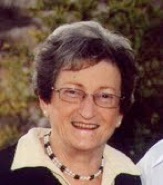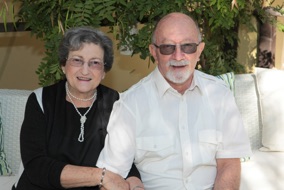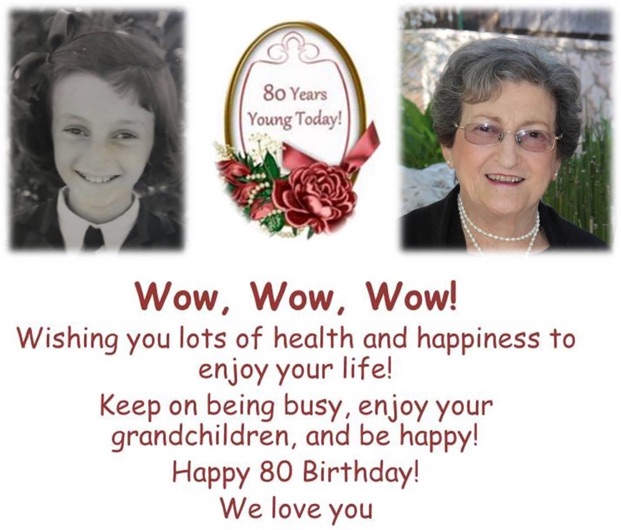Kimberley, South Africa


Goodman (nee Cohen), Sarah


1960 2009
Name
Sarah Goodman
Maiden Name
Cohen
Year of birth
1937
3 words that exemplify what it was like growing up in Kimberley
An amazing childhood
Date left Kimberley
1960
Age when left
23
Reason for leaving
Hardly any Jewish young people left in Kimberley
Scholastic achievements, degrees qualifications and where they are from
Matriculation at Kimberley Girls' High School. My parents had no money to send me to university and I always worked as a secretary in legal firms
Where you live now
Jack and I live on Moshav Neve Ilan in the Jerusalem Hills. The Moshav is making provision for all our children to buy plots or houses on the Moshav so in a few year's time we hope that all our children will be living here. We have 3 children and 9 grandchildren.
We are retired but keep ourselves very busy. Jack teaches wood carving to the elderly and has 5 classes. I volunteer at Yad Sarah, which started as a place to borrow medical equipment such as wheel chairs and crutches etc. It has expanded into a tremendous helping hand society to the elderly and the mentally and physically handicapped, especially children. There are about 150 branches all over Israel.
What you do
Pensioner, volunteer at Yad Sarah's network of home care and support services for the home bound where I work as an editor in the life stories department.
Marital status
Married - will be 50 years next month! (10 November 1963)
Where partner born
Jack Goodman, was born in Bethlehem, South Africa.
What does your partner do?
Pensioner, sculptor and woodcarving teacher
How many children
3 - a son, Shaun, and 2 daughters, Kim Ben Shalom and Lisa Zecharia
When were they born
They were all born in South Africa
Where do they live and what do they do
Shaun, the eldest lives on Moshav Neve Ilan with Sigal and has 3 boys and a girl. He is an Acupuncturist and also teaches Chinese Medicine).
Kim lives in Miami, U.S.A. with Guy Ben Shalom and has 2 boys. She has her own insurance business.
Lisa lives in Kfar Vradim, Israel, with Udi Zecharia and has 2 girls and a boy. At the moment she is a housewife and driver for her children's many activities after school.
STORY BY SARAH GOODMAN (COHEN)
SEPTEMBER 2017.
In 1961 I spread my wings and left Kimberley to live in Johannesburg where I met my husband Jack Goodman from Potchsfstroom and we were married in Kimberley in 1963. I always dreamed of getting married in the beautiful shul but I never knew that it was being renovated and we had to get married in the small hall at the side of the shul which funnily enough was called, the Minor Hall. We had 10 happy married years living in Johannesburg.
Jacky was a Zionist and we had discussed immigrating because of the political situation in South Africa. He would go nowhere else except to Israel but made a compromise that we should live on a moshav shitufi rather than a kibbutz which was far more rigid. We did not have enough money to live in the city and I don’t think we would have been happy anywhere else but on a communal settlement.
We arrived in Israel on 9 September 1973, with our 3 children, Shaun aged 7, Kim 5 and Lisa 2 years old. It was hard for all of us. We were at an Absorption Center on Kibbutz Mishmar Haemek. We all had to adjust to a new life and culture. We came with other South African families which made our absorption easier. We spent Rosh HaShanah with my cousin, Leib Golan (Leonard Goldberg from Kimberley), on Kibbutz Maayan Baruch. Leib was a true Zionist and one of the founders of the Kibbutz. Sadly, he developed Alzheimers Disease and at the end of his life he did not know me. I remember at our first visit when he was showing us around the Kibbutz, I noticed that all the bomb shelters were crammed with unused furniture and when I remarked on this he said “there will be no more wars in Israel, we don’t need these shelters”.
A week later (three weeks after our arrival in Israel), on a Saturday afternoon we saw planes in the sky – that was the beginning of the Yom Kipur War. Mishmar HaEmek is very near a large army air base and there was constant air activity throughout the war. Our children had to sleep in the bomb shelters. The first two nights we took them down every time the siren sounded and after that the Kibbutz decided to bring beds into the shelter so they could sleep there until the war was over. It rained constantly and we were not used to winter rain. The entrance to the bomb shelter was covered in mud, we had no suitable boots to wear and all I wanted to do was go back to South Africa. Jack was so strong, he kept me going. All the men on the kibbutz were called up to serve in the army and Jack found himself in charge of the garage. A job he kept for the six months we lived there. I worked in the clothes-sorting department. The members of the kibbutz were very kind to us and we have many happy memories of our stay on the kibbutz.
We stayed at Kibbutz Mishmar Haemek for 6 months. Jack and the other South African husbands looked for places to live and because of the Yom Kippur War there was no public transport, but help was given by the Jewish Agency. We decided on Neve Ilan, which was founded by an American group from Young Judea sponsored by the Hadassah Women’s Organization. The houses were not yet completed but because we were new immigrants we transferred to an Absorption Center at Mevesseret Zion, which was near Neve Ikan, on 3 March 1974 where we lived for six months with other members awaiting their new homes on Neve Ilan. The house we chose was ready for occupation at the beginning of September 1974 when we moved onto Neve Ilan. There were no telephones (FOR 15 YEARS), no electricity (for 3 months) no landscaping or steps leading to our house and we “sludged” around in the mud for a few years before all the work was completed.
I had been used to having a maid in our home in South Africa who cleaned our house, cooked our meals and helped look after our three children. It was very hard for me to adjust to doing everything myself, cleaning, cooking and taking care of our children. After a few months I put my back out while making one of the beds and landed up in the old Shaare Tzedek Hospital on Jaffa Road. I could not speak Hebrew and no one spoke English. It was a very traumatic time for me.
The moshav decided to go into tourism starting with a small Vacation Centre which consisted of the houses on the moshav which were not being used by the members. We rented houses to tourists who were interested in coming on aliyah from America, and to educational groups for mothers from North African countries. I remember us cleaning all those houses which were left in a terrible state by the builders especially with stones blocking the toilets. We had no hired labour and did all the work ourselves. We would eventually end up by building our own hotel.
When the hotel was opened in 1982, I was asked to stay on to run the housekeeping department. I had a lot of experience from helping my sister, Fay, and her husband, Nathan Cohen who owned the Savoy Hotel in Kimberley. What fun and satisfying work it was for me to help furnish the rooms in our hotel and being the housekeeper. Eventually I worked in the office until I retired at the age of 72 in 2009.
Today I enjoy my retirement on Neve Ilan, a wonderful moshav where I have been living for the past 43 years – watching my children growing up, and having 9 wonderful grandchildren. I would not live in any other place in the world.
**********************************
The impact of Holocaust survivors’ stories on Sarah Goodman (nee Cohen b Kimberley 1937 now living in Israel)
posted September 2014
Kimberley – indeed the whole of South Africa was a saving haven to hundreds of thousands of Jewish people from Eastern Europe, whose bravery in undertaking such a hazardous journey into the unknown, saved them and their families from certain destruction in the Holocaust, and allowed them and their children and grandchildren to flourish and contribute to societies all over the world. Sarah (Cohen) Goodman who works with Holocaust survivors in Israel drawing out their stories writes below:
The impact life stories have on me as a volunteer at Yad Sarah
where I proofread many of the stories as told by survivors of the Holocaust
There is a saying, “During a storm the mud of the river comes up to the top,” and so it was in human society at the time of the Holocaust. We found that during the war the lowest characters of society suddenly rose to leading positions. That in turn dragged down the moral values of such a society. The whole pattern of behaviour changed so that what was once forbidden was now acceptable.
In one of the first stories that I read concerning the survivors of the holocaust, the storyteller related that there were times later in her life, after her husband died at a comparatively young age, when she felt at the end of the road. It seemed that the easiest way out for her would be to drive her motor car up onto a pole to solve all her problems. However, just for a split second she would hear in her ears the voice of a woman from the days of being in the concentration camp crying “My Children, my children, don’t take them away”. At that instant, she understood that this poor woman was not given a choice, but with G-d’s grace she, the storyteller, did have a choice, and she thanked the Almighty there and then. She made up her mind that the responsibilities of bringing up her children were hers and hers alone and there was no one in the whole world who could do it for her.
In another story we see what those brave people did to try and survive. The storyteller relates that the winter of 1942 was very, very cold. There was no heating, not much to do, and not much to eat, so to keep warm they would stay in bed, sometimes fully clothed even with gloves on. As they were breathing the steam was visible in the air, and they used to play games competing over whose breath would stay the longest in the air. Sometimes G-d eases one's suffering with beauty. Although they were freezing inside, the window panes were a miracle to behold. The ice and the frost had created the most beautiful pictures of flowers, most of them in the shapes of tulips and those long stemmed chrysanthemums. When the sun shone on them, it gave the impression of brilliance as if those flowers were diamond-studded jewels. They would sit and watch them until the midday sun melted the lot. Another benefit of staying in bed longer on those frosty mornings, besides keeping warm, was that they then needed less food, and in that manner they survived the winter.
Sarah Cohen Goodman
MoshavNeve Ilan
Israel
May 2011





